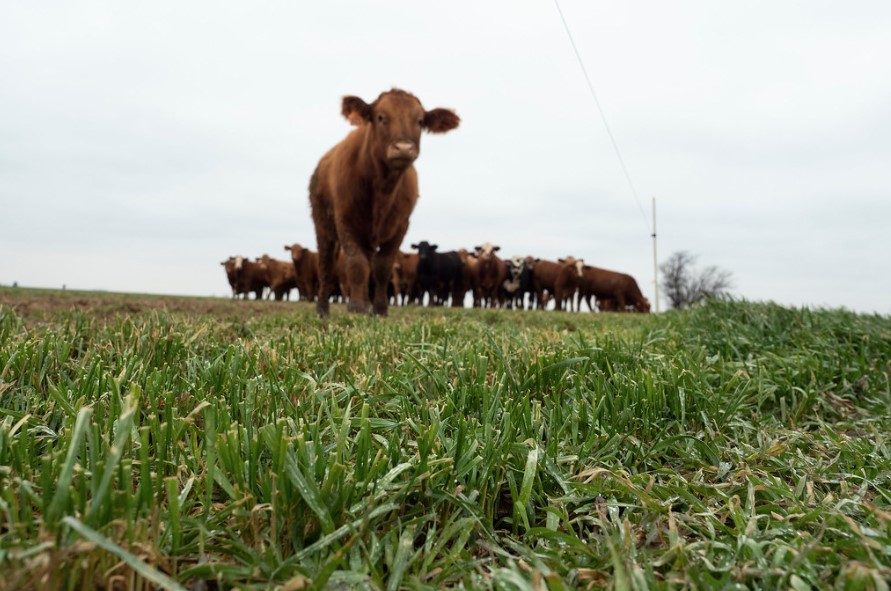
Agricultural News
To Graze or Grain? Producers Gear up for Wheat Planting Season
Mon, 19 Sep 2022 11:13:34 CDT
 Drought conditions are still a major factor right now as producers strategize when and how much wheat to sow over the next few weeks.
Drought conditions are still a major factor right now as producers strategize when and how much wheat to sow over the next few weeks.
A current lack of subsoil moisture limits wheat’s potential to sprout and germinate, and some farmers may decide to “dust in” wheat. The Oklahoma State University Extension fact sheet on planting dual purpose wheat explains dusting it in as a technique that plants seeds in shallow soil (less than 1 inch) in the hopes of rainfall later this fall.
Greg Hartman, agriculture and 4-H educator for Oklahoma State University Extension in Washita and Beckham counties, said in addition to the heat and dry climate, grasshoppers and armyworms are still present and could damage tender wheat seedlings. However, ranchers in desperate need of fall grazing pastures may already have some wheat in the ground.
“Everybody is getting anxious (to plant) as the days get shorter,” he said. “A lot of people think Sept. 15 is the optimal time to plant according to old timers, but it’s been proven by OSU researchers that whether you plant on Aug. 20 or Sept. 15, it’s all about on the same pace come Nov. 15.”
Only 15-20% of the wheat planted in Hartman’s area of western Oklahoma will be harvested for grain. The rest is used as a forage source for cattle. Hartman encourages producers to ask their county OSU Extension office for assistance in conducting a soil test before planting. Residual nitrogen and other minerals are common this year in soil results because of drought conditions.
Josh Bushong, OSU Extension area agronomist for the west district, explained on a recent episode of the Extension Experience podcast that nitrogen and residue management affect forage yields in wheat pastures.
“If you have a lot of residue from the previous wheat crop or failed summer crop, you’re going to have a harder time getting pasture established,” he said. “While the crop residue has benefits such as soil water retention, it can make it more difficult to get proper seed to soil contact for good seed germination. Focus on fallowed or tilled fields for fall pasture, and for those other fields (with residual nitrogen tied up in the crop residue), delay planting until October and target just a grain crop instead of forage and grain.”
Bushong said producers planting wheat for fall pasture should make available at least 60 pounds of nitrogen per acre (between soil residual and applied fertilizer) to ensure at least a ton of forage production. For a grain-only crop, he recommends no more than 40 pounds.
“If you’re turning cattle out to fall pasture, the biggest thing is early establishment,” Bushong said. “The quicker we can get that plant up and growing, the more biomass we’re going to produce in the fall.”
For farmers sowing dual-purpose wheat, 90 to 120 pounds of seed per acre is the normal rate. Bushong said producers should calculate their seeding rates based on forage needs and expected stocking rates of a pasture.
The rising costs of fuel, fertilizer and other materials are also a variable this fall. Kim Anderson, OSU Extension grain marketing specialist, said wheat prices have leveled out and show little volatility right now, but international pressures, such as the war in Ukraine and the building conflict between China and Taiwan, could quickly move market prices in either direction.
“We could see $6 bushel per acre wheat or $14 bushel per acre wheat (next year), but the market is telling us right now that we’re going to see $8 per acre,” Anderson said.
OSU Extension uses research-based information to help all Oklahomans solve local issues and concerns, promote leadership and manage resources wisely throughout the state's 77 counties. Most information is available at little to no cost.
WebReadyTM Powered by WireReady® NSI
Top Agricultural News
More Headlines...





